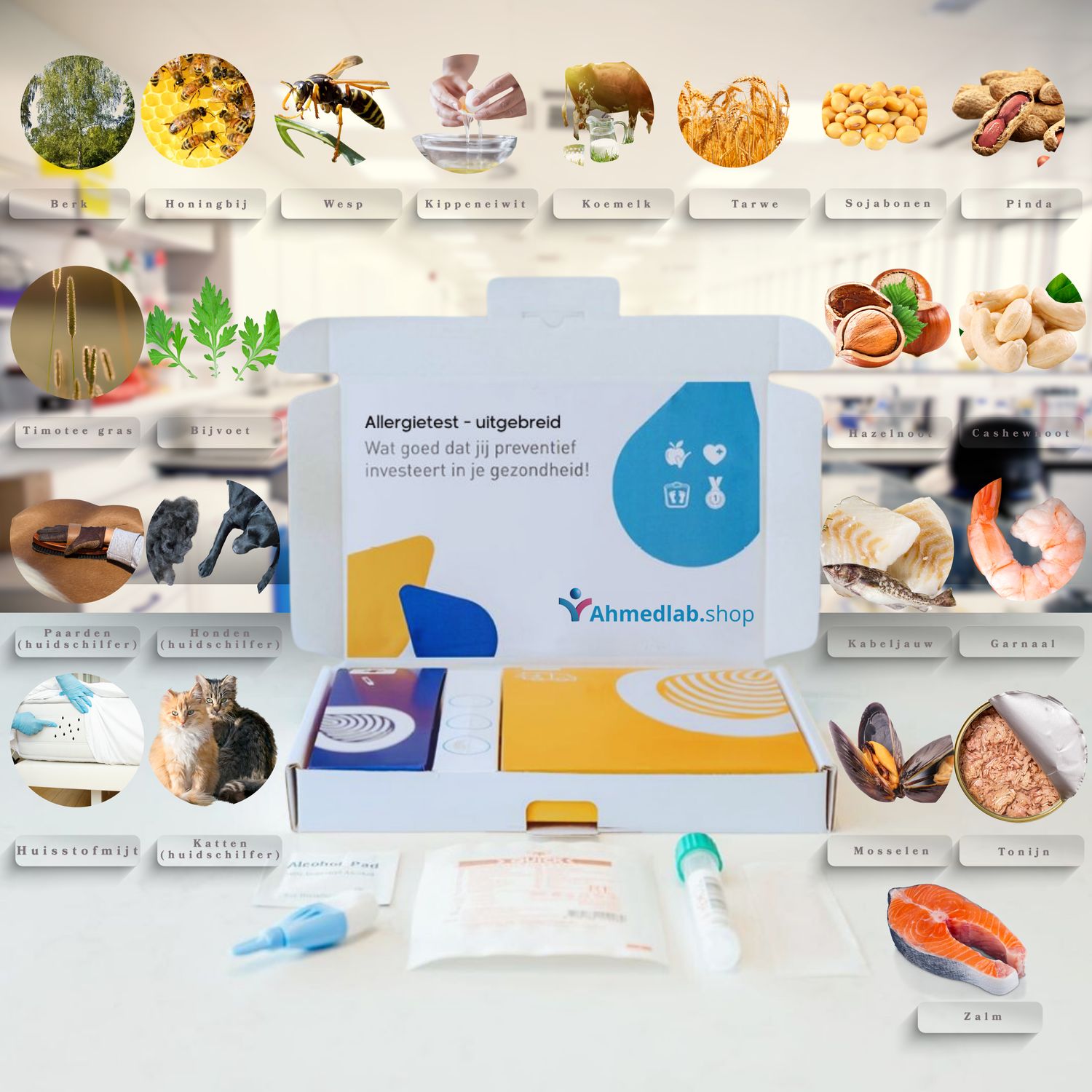Comprehensive Allergy Test (Food, Inhalation & Insect Venom)
About the test
Do you suspect that in addition to a food allergy, you might also have an inhalation allergy or an allergy to insect venom? Or are you unsure where your allergy comes from?
Then we recommend this most complete package: the extended allergy test.
Measurements (sIgE)
- House dust mite
- Cats (dander)
- Horses (dander)
- Dogs (dander)
- Timothy grass
- Mugwort
- Birch
- Honeybee
- Wasp
- Egg white
- Cow’s milk
- Wheat
- Soybeans
- Peanut
- Hazelnut
- Cashew
- Cod
- Shrimp
- Mussels
- Tuna
- Salmon
Examination: blood (finger prick)
Instructions
When to test
A general feature of allergy testing is that even in the absence of allergic symptoms, the sIgE test may sometimes be positive. In this case, there is no allergy. We therefore advise against testing for allergies if you have no symptoms.
How it works
You collect a blood sample at home with a simple finger prick. You then send the sample by mail to our laboratory where it is reliably tested. If you are allergic, the blood test will show that specific IgE antibodies are being produced in your blood against the allergens to which you are allergic.
How does the ahmedlabshop method work?
Order test
You receive a mailbox package with all the materials needed to easily collect blood via a finger prick.
Sending the blood sample
We use a unique preservation solution so that your blood remains stable and can be sent by regular post.
Result
After the laboratory receives the blood, the test result will be available within 10 working days. You will receive an SMS with which you can view and download your test result online. The test results come with a clear explanation and recommendations.
Symptoms
The following complaints may indicate an allergic reaction to food:
Symptoms of a food allergy usually appear quickly after eating the food. In young children, symptoms often include gastrointestinal problems and skin complaints (e.g. eczema). In adults, the symptoms can vary greatly from person to person.
Gastrointestinal system:
A typical allergic reaction to food begins with an itchy feeling in the mouth. This may be followed by swelling of the lips and throat (sometimes also the eyes), nausea, abdominal pain, and vomiting.
Skin reactions:
Skin reactions may also occur (itching, rash, hives).
Cardiovascular complaints/anaphylaxis:
In very severe cases, cardiovascular problems may occur such as low blood pressure, dizziness, fainting, and anaphylactic shock. An anaphylactic shock is a very serious (potentially fatal) allergic reaction that occurs suddenly and involves multiple organs. Fortunately, such severe reactions are rare.
Respiratory tract:
Asthmatic complaints, bronchitis, shortness of breath, nasal or eye problems.
The following complaints may indicate an allergic reaction to inhalation allergies (hay fever, pet allergy, dust mite allergy):
- Nasal complaints: runny nose, sneezing, blocked nose.
- Eye complaints: red, watery, itchy eyes
- Lung problems: shortness of breath, coughing, wheezing.
- Skin problems: eczema, hives
The following complaints may indicate an allergic reaction to insect venom:
- Nausea
- Dizziness
- Itching (redness/skin rash in places where you were not stung)
- Swelling
- Severe headache
If you have a (severe) allergic reaction, in addition to local reactions you may also experience symptoms involving multiple organs such as the skin, gastrointestinal tract, lungs, central nervous system, heart and blood vessels.
Severe symptoms include:
A severe asthma attack, swelling in the throat, or going into shock.
Test results
About the result
The result of the blood test is shown as a positive or negative outcome and explained with the measured concentration. The level of sIgE does not predict how severe the allergic reaction will be. However, the higher the sIgE, the greater the likelihood of an allergic reaction to the tested allergen. An increased concentration of antibodies combined with allergic symptoms is a strong indication of an allergy.
People with hay fever may also react to certain foods. This is because the immune system cannot distinguish between these protein structures. This may cause an allergic reaction to foods. This is called cross-reactivity. All known cross-reactions are indicated in the result.
It is also possible that the value is elevated without symptoms suggesting an allergy.
We advise that in case of an increased concentration of sIgE combined with symptoms suggestive of an allergy, you should always consult a (family) doctor for a definitive diagnosis and possible treatment.
FAQ
When should I test for allergies?
A general feature of allergy testing is that even in the absence of allergic symptoms, the sIgE test may sometimes be positive. In this case, there is no allergy. We therefore advise against testing for allergies if you have no symptoms.
How does the test work?
You collect a blood sample at home with a simple finger prick. You then send the sample by mail to our laboratory where it is reliably tested.
How long does it take to get the result?
After the laboratory receives the blood, the test result will be available within 10 working days. You will receive an SMS with which you can view and download your test result online.
How reliable is the result?
The result of the blood test is shown as a positive or negative outcome and explained with the measured concentration. The level of sIgE does not predict how severe the allergic reaction will be.
What should I do if my sIgE value is elevated?
We advise that in case of an increased concentration of sIgE combined with symptoms suggestive of an allergy, you should always consult a (family) doctor for a definitive diagnosis and possible treatment.


